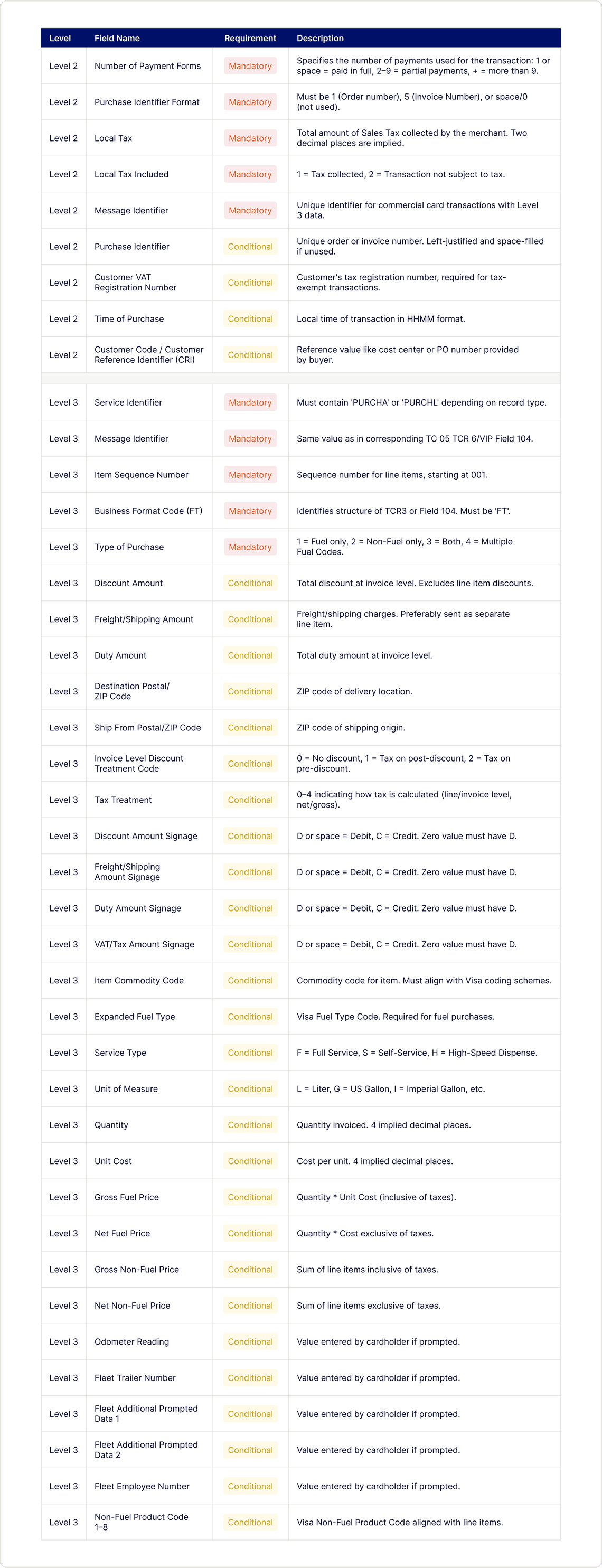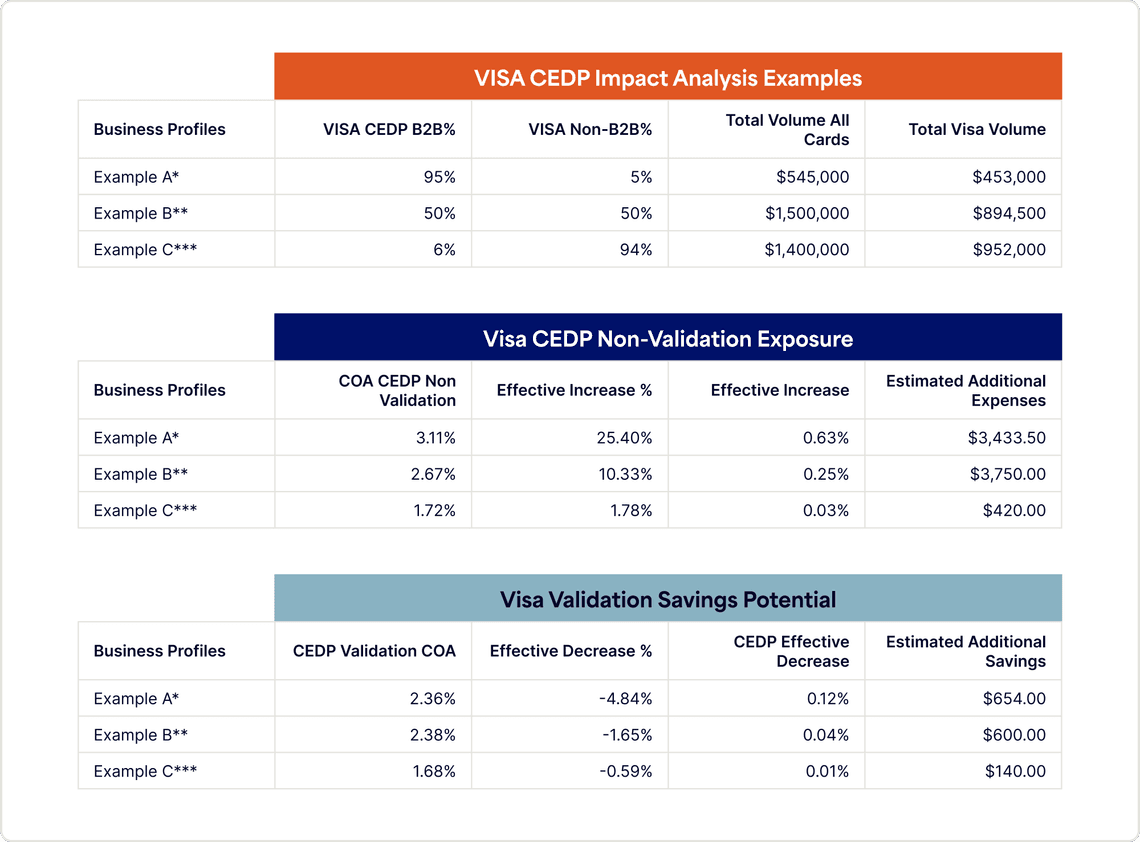Information on Visa's Commercial Enhanced Data Program (CEDP)
Visa's interchange program is a card brand initiative to improve the quality of transaction data on business credit card purchases.
Table of contents
Overview
What is CEDP?
Visa's Commercial Enhanced Data Program (CEDP) is a card brand initiative to improve the quality of transaction data on business credit card purchases. Starting October 17, 2025, merchants must provide complete, accurate Level II/III enhanced data to maintain optimal interchange rates.
Key changes
Simply including some Level III data is no longer enough. Data must be correct, comprehensive, and descriptive. Generic placeholders or "dummy" data may result in transaction downgrades and higher fees.
Verified versus non-verified status
Visa determines if the data provided with transactions meets their new specifications. If the data passes Visa's requirements, Visa will classify the merchant as verified. If the data does not pass, Visa will classify the merchant as non-verified. Merchants in non-verified status will not be eligible for interchange incentives until errors are resolved.
✓ Verified merchant
- Consistently submits complete and accurate Level II/III data
- Earns verified status in Visa's system
- Eligible for reduced CEDP (Product 3) interchange rates
- Minor occasional errors are tolerated
- Benefits from lower costs and better data analytics
✗ Non-verified Merchant
- Does not consistently provide required enhanced data
- Lacks verified status in Visa's system
- Not eligible for interchange incentives
- Transactions often downgraded to higher fees
- Risks removal from Level III pricing eligibility
NOTE: Visa will continually analyze merchants' data integrity and can change the verification status at any time. Verification is not controlled by Versapay.
Why verification matters
Benefits of compliance
- Lower interchange rates: Access to new Level III rates that are even better than traditional Level 3 rates
- Avoid downgrade fees: Complete data prevents costly transaction downgrades
- Better customer relationships: Detailed data supports customer accounting needs
Risks of non-compliance
- Higher processing costs: Downgraded transactions carry higher interchange fees
- Loss of eligibility: Risk removal from Level III pricing programs entirely
- Operational disruption: Last-minute scrambling to meet requirements
Important timelines and dates
April 2025: Program launch and fees begin
Visa launches CEDP in the U.S. Starting April 12, 2025, a new "participation" fee of 0.05% is applied to commercial card transactions that include Level II or III data. This fee is designed to incentivize merchants to comply with the program. Visa also begins initial data quality validations in this period.
October 17, 2025: Data quality enforcement
This is a critical date for merchants. As of October 17, 2025, Visa will fully enforce CEDP standards. Only transactions from verified merchants providing complete, accurate enhanced data will qualify for the best "Level III" interchange rates. Merchants with poor data quality will be flagged as non-verified, and their transactions will incur higher interchange costs.
April 2026: Legacy programs sunset
By April 18, 2026, Visa will retire the old Level II program entirely. At this point, CEDP and its stricter standards will be fully in effect for all B2B credit card transactions. Enhanced data has transitioned from a "nice-to-have" to an expected norm for earning lower rates.
Data requirements
Under CEDP, merchants must submit comprehensive Level III data including:
Product information
Detailed product descriptions
Product quantities
SKU numbers and item codes
Unit costs per item
Financial details
Extended amounts
Tax information
Freight costs
Discount amounts
Business information
Merchant tax ID
Supplier tax ID
Customer reference numbers
Purchase order numbers
Critical requirement
All data must be real, accurate, and descriptive. Visa's validation technology will identify and reject:
- Generic descriptions (e.g., "Product," "Service," "Item")
- Placeholder data or dummy values
- Artificially generated content
- Incomplete or missing required fields
NOTE: We recommend you carefully read Visa's CEDP material to verify the most up to date requirements.
Versapay's recommended immediate actions
For all merchants
- Review and confirm your existing data quality, audit current submission processes, and ensure your integration or payment gateway passes all required fields accurately
- Ensure all data is granular and accurate
- Review tax considerations for your customers—even if you do not wish to charge tax, always include a value
- If you have a custom ERP integration, ensure your API code meets Visa’s new regulations
- Plan now for October 17, 2025, enforcement date
If you use a Versapay ERP integration
Do all the above and take these additional steps:
- Important upgrades may be required to your ERP application
- Review data your finance team enters into invoices and customer records
With Versapay's ERP integrations, interchange eligibility depends on the data sent with each transaction, and we're working to ensure our configuration pathways support the transmission of enriched data fields—like tax details, line items, and PO numbers.
How Versapay is preparing: a next generation payment platform
Versapay is building a next-generation payment platform designed to meet the evolving demands of B2B payments—including compliance with Visa’s CEDP mandate. We’re upgrading and unifying our infrastructure to support policy changes and deliver the latest in B2B payment innovation.
As we roll out new capabilities, you’ll see enhancements that improve data quality, streamline compliance, and unlock interchange savings. This is just the beginning—we’ll keep you informed as we introduce features that redefine what’s possible in B2B payments and AR automation.
Versapay's commitment
Our mission is to remove friction in payments and cash flow. We're here to support you. If you have any questions or concerns outside of the resources below, please contact [email protected].
Additional resources
CEDP L2 / L3 mandatory and conditional fields

CEDP impact analysis examples

* Merchant accepting 95% of their Visa Volume in B2B Visa Categories that are impacted by changes with CEDP enforcement for select business, purchasing and corporate cards
** Merchant accepting 50% of their Visa Volume in B2B Visa Categories that are impacted by changes with CEDP enforcement for select business, purchasing and corporate cards
*** Merchant accepting 6% of their Visa Volume in B2B Visa Categories that are impacted by changes with CEDP enforcement for select business, purchasing and corporate cards
Calculations
1. COA (Cost of Acceptance) =
➝ Total Processing Fees / Total Card Volume Funded
2. Effective Increase % =
➝ Estimated Anticipated Expenses / Previous Fees Occurred
3. COA CEDP Non-Validation (New Anticipated COA With Client in Non-Validated Status and/or Failing to Send Data That Meets Visa's New Requirements With CEDP) =
➝ Total Processing Fees + Estimate Additional Expenses / Total Card Volume Funded
4. CEDP Validation COA (New Anticipated COA With Client in Validated Status Sending Data That Meets Visa's New Requirements With CEDP) =
➝ Total Processing Fees - Effective Savings / Total Card Volume Funded
5. Effective Decrease % =
➝ Effective Savings With CEDP Validation / Previous Fees Occurred